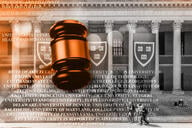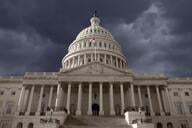You have /5 articles left.
Sign up for a free account or log in.
A union was not available to me as an adjunct lecturer at St. John’s University, but I immediately joined when I was hired full time. Years later, I led faculty union negotiations on behalf of the administration at Niagara University. In both cases, the Catholic universities for which I worked voluntarily cooperated with unions as a way to give the faculty a structured, formal voice for its concerns. Today, the nation’s largest Catholic higher education institution, DePaul University -- where I am president -- enjoys productive relations with unions representing catering and facility services as well as numerous construction trades.
It is ironic, then, that as the national movement to organize part-time faculty now targets DePaul, I will oppose it for a reason having nothing to do with unions or part-time faculty.
Recent rulings of the National Labor Relations Board have put several of our Catholic institutions in the unenviable position of having to oppose organizing efforts of part-time faculty at our institutions. In December 2014, the NLRB asserted that it will take jurisdiction over faculty members at religious universities unless the institution holds them out “as performing a religious function in furtherance of its religious mission.” In the past few months, several NLRB regional offices have accepted this new legal standard and asserted jurisdiction over local Catholic institutions.
The NLRB is attempting to extend its authority over faith-based institutions, something Supreme Court and appellate court precedent has repeatedly rejected. That in itself is not surprising. Their specific approach, however, is deeply problematic, for it requires government functionaries to judge the manner in which we implement our faith in a university context, the very thing the Supreme Court and U.S. district courts found troubling.
Nor is it working in practice. Just within the past three weeks, one regional NLRB concluded that it could not exercise jurisdiction over Carroll College because of the college’s religious identity, while another regional NLRB concluded it could exercise jurisdiction over Loyola University of Chicago. It is exactly this kind of result, where a government agency decides that one Catholic institution is sufficiently religious, but another Catholic institution somehow is not, that the court hoped to avoid.
To understand, it’s valuable to start by recalling the history of Catholic institutions in America.
In the 19th century, when public anti-Catholicism was the unfortunate norm, it was common for nativists to condemn Catholics for failing to divide the world into rigidly separate spheres of religion and secular politics. Catholics, it was said, couldn’t be good American citizens unless they rejected any role for religious faith in their civic lives.
In that environment of persistent prejudice, Catholic educational institutions were singled out for combining faith and reason, religious mission and worldly goals. Catholic colleges and universities became the targets of virulent legal campaigns, including a movement for a national constitutional amendment to bar any form of government support for them.
In the modern era, the Supreme Court gradually took steps to remedy this unfortunate history of anti-Catholic bias. It did so by recognizing a right for religious institutions to reach their own determinations about the relationship between their religious and worldly affairs.
A linchpin of this epochal process was the court’s decision in a 1979 case, NLRB v. Catholic Bishop of Chicago. In that landmark case, a unanimous court squarely rejected the NLRB's attempt to expand its jurisdiction to include religious educational institutions.
Chief Justice Warren Burger held that the goal of the First Amendment was to protect the “religious mission” of the educational institution -- in particular, teaching. If the NLRB were to exercise jurisdiction over faculty-related labor matters, Burger explained, that would “necessarily involve inquiry into the good faith of the position asserted by the clergy-administrators and its relationship to the school's religious mission.”
And the court added a further protection: “It is not only the conclusions that may be reached by the Board which may impinge on rights guaranteed by the Religion Clauses, but also the very process of inquiry leading to findings and conclusions.” Chief Justice Burger and his colleagues were concerned that, once the NLRB took jurisdiction, its role in governing the institution and its norms could become far-reaching and in direct violation of the constitutional protection of religious freedom.
The importance of the Catholic Bishop case lay in its explicit recognition that “the church-teacher relationship in a church-operated school differs from the employment relationship in a public or other nonreligious school.” Repudiating past history of anti-Catholic discrimination, the court acknowledged that it was for the college or university and its clergy-administrators to define the nature of the institution’s religious mission and its core element of education.
The Integration of Faith and Reason
Crucially, for any Catholic institution, there can be no sharp division of the educational process or that institution’s mission into mutually exclusive realms of religious and secular. The church’s teaching, developed most powerfully by St. Thomas Aquinas and carried to the present, has always emphasized the integration of faith and reason. For a Catholic institution, as for individual Catholics, elements such as science, mathematics, service, charity, history and faith form an integrated whole that infuses all aspects of university life.
Yet, in practice, the NLRB proposes to decide which of our faculty are contributing to the religious mission of the institution, with a narrowness we reject, thereby ignoring Catholic universities’ explanation of the integrated function of faculty across the university.
In so doing, the NLRB -- perhaps unwittingly -- has reasserted the 19th-century bias that the Supreme Court repudiated in 1979. The court’s precedent recognizes that it is up to the institution to determine and govern its mission. The NLRB claims, to the contrary, that it will divide education into mutually exclusive secular and religious spheres and be the judge of whether a particular teacher’s function is “religious.”
Effectively, the NLRB is asserting that the teaching of science or history or international finance is inherently secular and cannot be part of an integrated, unified religious mission. The NLRB -- a branch of the government -- is substituting its binary understanding of the relationship between faith and reason for the judgment of the Catholic University and indeed of the church herself.
Yet as a matter of religion, a Catholic institution must insist on the unified integrity of its teaching faculty into a single overarching mission. The faculty cannot be divided into “religious” and “secular” faculty by government fiat without impugning the Catholic mission itself.
Religion is on the table in Catholic colleges and universities. From nursing to political science, from religious studies to art history, from psychology to ethics, professors may choose to inflect their teaching with religious content. Almost any topic can be taught in a pervasively religious way, if the instructor designs the course with religious objectives and values in mind.
Ideally, the overall ethical-religious mission of a Catholic institution infuses all classes, and indeed all contact between faculty members and students. Shaping that mission is a matter of faith that deserves protection as a matter of religious liberty under the Constitution. Regardless of whether or not a particular faculty member chooses to incorporate religion in his or her classroom overtly, the point is that it is up to the university, not the government, to decide what counts as religious perspective.
Church teaching has long recognized that unions can be an important part of a worker’s right to organize and control his labor. Far from being antipathetic to unions, many Catholic institutions, including my own university, work with unions and respect their role.
What’s at stake in the current situation is something completely different: the hard-won fundamental First Amendment right of Catholic universities to apply our own conception of our religious-educational mission. That mission depends on the rich, meaningful and ancient integration of faith and reason in education and ultimately in the self.
Several Catholic universities now find themselves in the positions of deciding whether to oppose the attempt of the NLRB to assert jurisdiction on this new legal basis. The freedom to determine what is or what is not religious activity inside our church is at stake.
Doubtlessly, some will argue that Catholic colleges and universities are merely hiding behind these arguments in order to resist the unionization of their faculties. Yet it is crucial for Catholic institutions to resist the NLRB’s assertion of authority in its attempt to get the power that the Supreme Court denied it in 1979. If the NLRB is able to subvert or reverse the court’s binding precedent, the consequences will be grave -- not only for Catholics but also for all Americans.
Today, thankfully, Americans of all faiths and of none deeply and broadly respect our country’s heritage of religious liberty. Catholic educational institutions, targeted and victimized in the American past, bear a special responsibility to stand up for constitutional freedom and equality.




